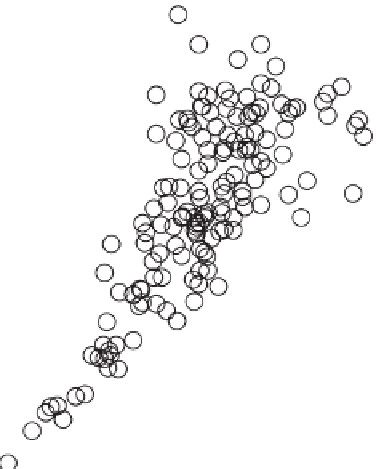Agriculture Reference
In-Depth Information
adjacent groundwater (Allen et al. 1972, Tague 1977, Rheaume 1990, Kehew et
al. 1996), although the relative importance of groundwater and precipitation var-
ies. Lakes fed primarily by groundwater (commonly known as “spring-fed lakes”)
are the most common, as evident from the distribution of their conductances (Fig.
11.2). As noted earlier, lakes around KBS are similar in their spatial and temporal
hydrologic variation to lakes in the vicinity of the North Temperate Lakes (NTL)
LTER site (Webster et al. 2006). However, in contrast to lakes at NTL, lakes around
KBS contain more alkaline, ion-rich water, reflecting the influence of the abundant
carbonate minerals in glacial deposits.
Groundwater-fed lakes around KBS commonly exhibit high rates of calcite pre-
cipitation during the summer, when water temperatures warm and aquatic primary
production increases the pH through assimilation of CO
2
(Hamilton et al. 2009).
Carbonate precipitates often build up in the sediments of such lakes. The effect
of calcite precipitation on lake Ca
2+
concentrations is significant: up to half of the
Ca
2+
in groundwater inputs may precipitate out during the summer (Fig. 11.11).
Figure 11.11
. Calcium (Ca
2+
) and magnesium (Mg
2+
) concentrations in southern Michigan
lakes during the summer, and in groundwater from wells at KBS. Assuming similar ground-
water composition across the Lower Peninsula, precipitation water inputs would dilute the
ion concentrations along the dashed line, whereas calcite precipitation would lower the ratio
of Ca
2+
to Mg
2+
. Data based on 152 lakes across southern Michigan, most sampled once in
the summer from 1996-2008, and 16 groundwater wells with variable sampling dates.














































































